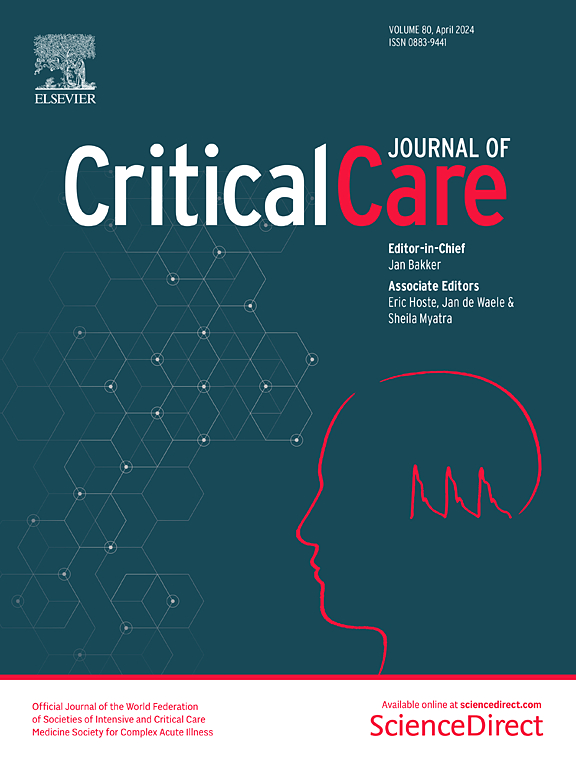基于创伤性脑损伤患者放射学特征的颅内高压预测模型的建立和验证:基于CENTER-TBI数据的探索性研究
IF 8.8
1区 医学
Q1 CRITICAL CARE MEDICINE
引用次数: 0
摘要
头部计算机断层扫描(CT)是评估外伤性脑损伤(TBI)患者颅内状况的常规检查,放射学表现有助于提示颅内高压的存在。目前,颅内高压的预测主要是基于对影像学特征的人工判别。我们的研究目的是通过全自动CT图像分割、严格的放射学特征提取和可靠的模型开发和验证,建立预测颅内高压的模型。我们的研究纳入了重症监护病房(ICU)接受颅内压(ICP)监测的患者。对于发展队列,我们从CENTER-TBI数据库中提取数据,并将数据随机分为训练组和试验组。对于验证队列,我们从上海总医院住院的患者中提取数据。初始记录的ICP值大于或等于20mmhg的患者被定义为颅内高压。从头部CT中提取放射学特征,包括影像学特征和三类放射学特征。对所有影像学表现进行特征选择。在选取图像特征的基础上建立形态学模型。根据选取的放射学特征建立一阶、二阶和三阶模型。在所有选定的放射学发现的基础上建立了一个综合模型。通过逻辑回归(LR)、随机森林(RF)、多层感知器(MLP)和极端梯度增强(XGB)四种分类器对这五种模型的性能进行评估,从中选出最佳分类器。经过模型训练和外部验证的过程,我们最终使用最优分类器生成预测能力和稳定性更强的预测模型。建立了形态模型、一阶模型、二阶模型、三阶模型和综合模型。最优分类器为logistic回归(LR)分类器,外部验证组形态学、一阶、二阶、三阶和综合模型的auc分别为0.75、0.77、0.76、0.86和0.83,F1得分分别为0.54、0.73、0.63、0.72和0.75。我们成功地建立了一个基于放射学特征预测颅内高压的模型。该模型可作为预测颅脑损伤患者颅内高压的一种方法。本文章由计算机程序翻译,如有差异,请以英文原文为准。
Development and validation of intracranial hypertension prediction models based on radiomic features in patients with traumatic brain injury: an exploratory study based on CENTER-TBI data
Head computed tomography (CT) is a routinely performed examination to assess the intracranial condition of patients with traumatic brain injury (TBI), and radiological findings can help to indicate the presence of intracranial hypertension. At present, the prediction of intracranial hypertension is mainly based on manual discrimination of imaging characteristics. The aim of our study was to establish a model to predict intracranial hypertension via fully automatic CT image segmentation, rigorous radiomic feature extraction and reliable model development and validation. Patients admitted to the intensive care unit (ICU) who underwent intracranial pressure (ICP) monitoring were included in our study. For the development cohort, we extracted data from the CENTER-TBI database and randomly divided the data into a training group and a test group. For the validation cohort, we extracted data from patients admitted to the Shanghai General Hospital. Patients whose initial recorded ICP value was greater than or equal to 20 mmHg were defined as having intracranial hypertension. Radiological features, including imaging characteristics and three categories of radiomic features, were extracted from the head CT. Feature selection was performed for all radiological findings. A morphological model was built on the basis of selected imaging characteristics. First-order, second-order and third-order models were built on the basis of selected radiomic features. A comprehensive model was built on the basis of all selected radiological findings. The performances of these five models were assessed by four classifiers, including logistic regression (LR), random forest (RF), multilayer perceptron (MLP), and extreme gradient boosting (XGB), from which the best classifier was selected. After the process of model training and external validation, we ultimately used the optimal classifier to generate a prediction model with greater predictive power and stability. Five models were built, including a morphological model, first-order model, second-order model, third-order model and comprehensive model. The optimal classifier was the logistic regression (LR) classifier, with which the morphological, first-order, second-order, third-order and comprehensive models had AUCs of 0.75, 0.77, 0.76, 0.86, and 0.83 and F1 scores of 0.54, 0.73, 0.63, 0.72, and 0.75, respectively, in the external validation group. We successfully established a model for predicting intracranial hypertension on the basis of radiomic features. This model may serve as an approach for intracranial hypertension prediction in TBI patients.
求助全文
通过发布文献求助,成功后即可免费获取论文全文。
去求助
来源期刊

Critical Care
医学-危重病医学
CiteScore
20.60
自引率
3.30%
发文量
348
审稿时长
1.5 months
期刊介绍:
Critical Care is an esteemed international medical journal that undergoes a rigorous peer-review process to maintain its high quality standards. Its primary objective is to enhance the healthcare services offered to critically ill patients. To achieve this, the journal focuses on gathering, exchanging, disseminating, and endorsing evidence-based information that is highly relevant to intensivists. By doing so, Critical Care seeks to provide a thorough and inclusive examination of the intensive care field.
 求助内容:
求助内容: 应助结果提醒方式:
应助结果提醒方式:


